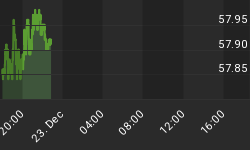The following is part of Pivotal Events that was published for our subscribers January 5, 2016.
Signs of The Times
"Europe's Mega-Banks Continue to Slash and Bleed"
"Global Woes"
- Bloomberg, December 23.
"New company claims they'll be able to resurrect the dead by 2045."
- Express, December 30.
This may seem like a breakthrough, but the US government has been paying social security to dead people for decades. What's more, the Democrats can get legions of them out to vote.
"The bank [BoJ], which owns about US $54 billion in exchange-traded [equity] funds is ramping up its purchases."
- Reuters, January 4.
"Crowd Favorites Strike Out In Opening Day Rout as Banks Sell Off"
- Bloomberg, January 4.
"Hedge Funds Lick Wounds after Tough Year"
- Financial Times, December 7.
"The Year That Nothing Worked"
- Bloomberg, December 27.
Perspective
Is the setback a violent correction or is it the start of another severe contraction?
Likely both.
Let's look to Mister Market and Mother Nature, who are really running the show. Central bankers and endless debates about miniscule changes in administered rates have been and will always be expensive distraction.
Historical market patterns and thorough technical research has been competent.
Last August's hit to global financial markets was preceded by significant reversals in spreads and the curve. Ironically, not even the Fed can prevent such reversals. The one in June and the "breakout" in July ended excessive speculation in all of the hot games.
During December the curve flattened to new "lows" for the move and spreads accomplished another "breakout". The latter was noted in our Special Memo of December 8th.
The Transports and the old Dow Theory anticipated the top of the general market (NYA) in May. At 7300 this week, the Transports have taken out the December low at 7361 and the August low of 7452. This is critical and if its prophetic nature continues this decline in the overall market could be more than a brief setback.
Stock Markets
The hit has very little to do with the Fed Rate increase or to the re-opening of large-account selling in China. If anything, these were catalysts. It has more to do with changes in credit markets that essentially started in June and became serious in July.
Out December 23rd Pivot concluded "Banks and Broker-Dealers remain elevated and are vulnerable."
Going the other way, we have been looking for the "Rotation" trade as resource and material sectors bottom. This would likely be in the November-December window.
Base metal miners (XME) declined to 14.20 a couple of weeks ago. The bounce made it to 15.85 and it has slipped to 14.62. The best on last year's Rotation was 29.
On the Oil Patch (XLE), the low has been 58.21 on December 21st. It was very oversold at 57 with the August hit. The rebound failed at the 50-Day at 71, and the index is back down to the 58 level. Essentially, this is the third test of the level.
Will it hold?
Doubtful, so positioning long can wait.
Last year's trade made it to 81.76 on May 1st.
The financial sector has been vulnerable and is slipping.
BKX traded above the 200-Day ma through November and this week has dropped below the 200 and the 50-Day moving average. This also takes out the last low at 72 a few weeks ago. Support at the August hit low at 67 may not hold.
Essentially, XBD is in the same pattern.
Of interest, both financial indexes peaked in July and reversed as credit spreads broke out on the trend to widening.
Out of the Shanghai Crash the Advance/Decline line rebounded to a double top set in November and is breaking down.
Currencies
The November rally drove the Dollar Index (DX) to 70 on the Daily RSI. The high was 100.60 and the correction was to 97.21. Since then it has remained above the 50-Day ma, which is constructive. Rising above 99.35 would likely pop it to the key high at 100.60.
Some work there and it could march up to the 109 level. Let's call it a target, which would be interesting.
The Canadian dollar is suffering a doctrinaire governor of the central bank. It will suffer the imposition of the extreme interventionist politics that has turned the formerly economically powerful Province of Ontario into a "have not" province.
Ontario has become even zanier than California.[1] And the prospect of the federal government becoming, well, hysterical about every political fad de jour suggests the Canadian dollar will continue down.
The decade of Conservative government was an attempt to return to limited government. Ironically, this was condemned as "austerity".
Liberal compulsions tend not to just intrude they are expensive.
Federally, economic nihilism will be imposed until it is seen not to work.
[1] Ontario's population is one/third of California's but it carries twice the total debt burden. The Financial Post reports that Ontario is the "world's most indebted sub-sovereign borrower."
Link to January 8, 2016 Bob Hoye interview on TalkDigitalNetwork.com: https://www.youtube.com/watch?v=4HcZ-IogzjA&feature=youtu.be
Listen to the Bob Hoye Podcast every Friday afternoon at TalkDigitalNetwork.com
















